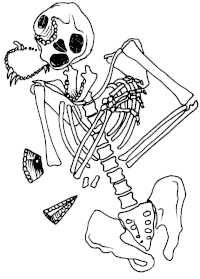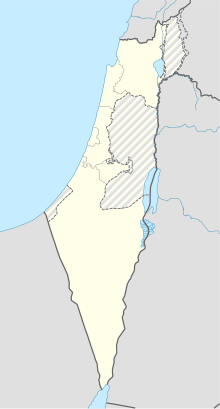| Revision as of 10:36, 10 February 2022 editGilabrand (talk | contribs)Extended confirmed users72,084 edits Reverted good faith edits by 128.62.69.253 (talk)Tags: Twinkle Undo← Previous edit |
Revision as of 10:41, 10 February 2022 edit undoGilabrand (talk | contribs)Extended confirmed users72,084 editsNo edit summaryNext edit → |
| Line 31: |
Line 31: |
|
}} |
|
}} |
|
|
|
|
|
'''Kebara Cave''' (]: מערת כבארה ''Me'arat Kebbara'', ]: مغارة الكبارة ''Mugharat al-Kabara'') is an Israeli ] ] locality in Wadi Kebara, situated at {{convert|60|to|65|m|ft|abbr=on}} ] on the western ] of the ], in the ] preserve of ].<ref>{{Cite web |url=http://www.ramat-hanadiv.org.il/sites/default/files/media/general_page/field_gp_related_files/Nature%20Park%20Map.pdf |title=map |access-date=2013-10-11 |archive-url=https://web.archive.org/web/20131010233100/http://www.ramat-hanadiv.org.il/sites/default/files/media/general_page/field_gp_related_files/Nature%20Park%20Map.pdf |archive-date=2013-10-10 |url-status=dead }}</ref> |
|
'''Kebara Cave''' (]: מערת כבארה ''Me'arat Kebbara'', ]: مغارة الكبارة ''Mugharat al-Kabara'') is a ] ] locality in Wadi Kebara, situated at {{convert|60|to|65|m|ft|abbr=on}} ] on the western ] of the ], in the ] preserve of ].<ref>{{Cite web |url=http://www.ramat-hanadiv.org.il/sites/default/files/media/general_page/field_gp_related_files/Nature%20Park%20Map.pdf |title=map |access-date=2013-10-11 |archive-url=https://web.archive.org/web/20131010233100/http://www.ramat-hanadiv.org.il/sites/default/files/media/general_page/field_gp_related_files/Nature%20Park%20Map.pdf |archive-date=2013-10-10 |url-status=dead }}</ref> |
|
|
|
|
|
==History== |
|
==History== |
|
The cave was inhabited between 60,000 and 48,000 ] and is famous for its ] finds of ] remains, made under the direction of Professor ]. |
|
The cave was inhabited between 60,000 and 48,000 ] and is famous for its ] finds of ] remains. |
|
|
|
|
|
] and ] excavated in the cave in the early 1930s, but by far the most significant discovery made at Kebara Cave was ] in 1982, the most complete postcranial ] ] found to date. Nicknamed "Moshe" and dating to ''circa'' 60,000 ], the skeleton preserved a large part of one individual's torso (], ]s and ]). The ] and most of the lower limbs were missing. The ] was also preserved, and was the first Neanderthal hyoid bone found.<ref name="mithen">](2006). The Singing Neanderthals: The origins of music, language, mind, and body. Cambridge, Massachusetts: Harvard University Press.</ref> |
|
] and ] excavated in the cave in the early 1930s. Excavations have since yielded a large number of human remains associated with a Mousterian archaeological context. The first specimen discovered in 1965, during the excavations of M. Stekelis, was an incomplete infant skeleton (Kebara 1).<ref></ref> |
|
|
|
|
|
The most significant discovery made at Kebara Cave was ] in 1982, the most complete postcranial ] ] found to date. Nicknamed "Moshe" and dating to ''circa'' 60,000 ], the skeleton preserved a large part of one individual's torso (], ]s and ]). The ] and most of the lower limbs were missing. The ] was also preserved, and was the first Neanderthal hyoid bone found.<ref name="mithen">](2006). The Singing Neanderthals: The origins of music, language, mind, and body. Cambridge, Massachusetts: Harvard University Press.</ref> |
|
|
|
|
|
The ] culture is named after the site. |
|
The ] culture is named after the site. |
 Kebara 2 in situ
Kebara 2 in situ
